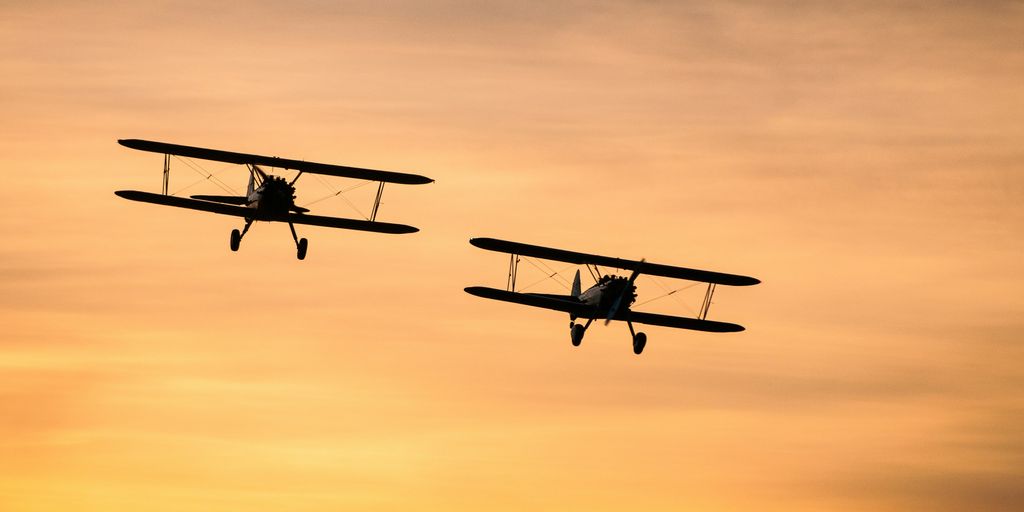
The history of aviation is a fascinating journey marked by groundbreaking innovations and technological advancements. From the early theories and designs that laid the groundwork for human flight to the sophisticated jetplanes of today, aviation has come a long way. This article delves into the key moments and milestones that have shaped the evolution of aviation, exploring its past, present, and future.
Key Takeaways
- The Wright Brothers’ successful flight in 1903 marked the beginning of modern aviation.
- World War II was a significant period for advancements in jet technology, leading to the birth of the jet age.
- Commercial jetliners revolutionized civilian air travel, making it faster and more accessible.
- Technological innovations in engines, avionics, and safety have continually improved jetplane performance and passenger comfort.
- The future of aviation looks promising with developments in sustainable aviation, supersonic jets, and autonomous aircraft.
Early Innovations in Aviation
Pioneering Theories and Designs
The dream of flight has ancient roots, with early inventors creating devices resembling wings. These initial attempts laid the groundwork for future innovations. Significantly in the history of aeronautics and aviation, the Wright brothers’ systematic engineering approach led to their continued success. Their pioneering research and experiments with wing design and aircraft control were crucial.
The Wright Brothers’ Breakthrough
In 1903, the Wright brothers successfully incorporated all required elements to create and fly the first aeroplane. Their basic configuration, with its characteristic tail, was established by 1909. This breakthrough was followed by rapid design and performance improvements, aided by the development of more powerful engines.
The Wright brothers’ success was not just about invention but also about systematic engineering and continuous improvement.
Advancements in Aerodynamics
Early innovations included hydraulic-mechanical flight control systems, but these were vulnerable to battle damage and took up a great deal of room. The period from 1910 to 1930 saw significant advancements in aerodynamics, leading to more practical and efficient aircraft designs. This era also witnessed the first public flight demonstrations in Paris in 1906, showcasing the potential of powered flight.
The Birth of the Jet Age
Origins of Jet Propulsion
The advent of jet aircraft in the 1940s completely revolutionized aviation. Early experiments in jet propulsion began in the 1930s, leading to the first operational jet aircraft, the German Heinkel He 178, in 1939. This marked a transcendental moment in aviation history.
World War II and Jet Technology
World War II accelerated the development of jet technology. The German Messerschmitt Me 262 and the British Boeing B-47 were among the first to see military service. These advancements laid the groundwork for future innovations and demonstrated the fundamental role of aviation in warfare.
The rapid development of jet technology during World War II showcased the potential of jet propulsion, driving aeronautical technologies forward.
Post-War Developments
The post-war era saw significant progress in jet propulsion. The introduction of the de Havilland Comet, the world’s first jet airliner, marked the beginning of a new era in civilian aviation. This period also saw advancements in engines and airframes, leading to the development of modern jetliners and business jets.
Jetplanes in Civilian Aviation
Commercial Jetliners
Commercial jetliners revolutionized air travel, making it faster and more accessible. The first commercial jet airliner to fly was the British de Havilland Comet. This innovation allowed airlines to transport passengers over considerable distances with unprecedented speed and comfort. The introduction of jetliners like the Boeing 707 and the Douglas DC-8 further solidified the dominance of jet propulsion in civilian aviation.
After World War II, commercial aviation grew rapidly, using mostly ex-military aircraft to transport people and cargo.
Business Jets
Business jets offer exclusive amenities and unparalleled convenience for elite travelers. These aircraft are designed to provide a luxurious and efficient travel experience, featuring eco-friendly engines, smart cabins, and even wellness spas. The demand for business jets has surged, driven by the need for privacy, flexibility, and time-saving travel options.
Technological Challenges and Solutions
The development of jetplanes in civilian aviation has not been without challenges. Engineers have had to overcome numerous obstacles, including noise reduction, fuel efficiency, and environmental impact. Innovations in aerodynamics, materials, and engine technology have been crucial in addressing these issues. Modern jetliners are now more efficient and quieter, contributing to a more sustainable aviation industry.
Military Jetplanes
The dawn of military jetplanes began with the Messerschmitt Me 262, the world’s first operational jet fighter. This revolutionary aircraft changed the dynamics of air combat during World War II, offering unprecedented speed and agility.
During the Cold War, the race for air superiority led to significant advancements in jet technology. Notable fighters of this period included the British Hurricane and Spitfire, the German Messerschmitt 109 and FW-190, and the U.S. P-47 Thunderbolt and P-51 Mustang. These aircraft set new standards in design and performance.
Today’s military jetplanes are marvels of engineering, featuring cutting-edge avionics, stealth capabilities, and advanced weaponry. They play a crucial role in modern warfare, providing air superiority and strategic advantages.
The evolution of military jetplanes has been marked by continuous innovation, driven by the need for speed, agility, and technological superiority.
Technological Advancements in Jetplanes

The evolution of jet engines has been marked by quantum leaps in technology. From the early turbojets to modern turbofans, each iteration has brought about significant improvements in efficiency and performance. Key innovations include:
- Supercharging for high-powered piston engines
- Swept wings and supercritical airfoils
- Lightweight composite materials
The development of gas turbine and turbofan engines has revolutionized both military and civilian aviation, enabling higher altitudes and faster speeds.
Modern jetplanes are equipped with state-of-the-art avionics and navigation systems. These technologies ensure safer and more efficient flights. Key advancements include:
- Integrated flight management systems
- Advanced radar and communication tools
- Enhanced autopilot capabilities
Avionics have not only improved safety but also contributed to the eco-friendly trends in aviation by optimizing flight paths and reducing fuel consumption.
Safety and passenger comfort have always been paramount in aviation. Recent technological advancements have focused on:
- Improved cabin pressurization and air quality
- Noise reduction technologies
- Advanced safety protocols and materials
Business aviation has long been at the forefront of advances in aviation technology, from winglets to composite materials, ensuring a safer and more comfortable journey for all passengers.
The Future of Jetplanes
The future will likely see further advancements that will take aviation to new safety, reliability, and efficiency levels. Further reducing an aircraft’s structural weight and substantially improving aerodynamic efficiency remains critical to reducing fuel consumption and operational costs. Electric propulsion systems will see continued developments, particularly for smaller aircraft, driven by improvements in battery technology.
- Hydrogen-powered jets
- Electric aircraft for short-haul travel
- Blended-wing designs
The future of aviation and aeronautical engineering is very promising, with continued innovation expected to take many types of aircraft to new levels of performance, efficiency, and sustainability.
Supersonic and hypersonic jets represent the next frontier in aviation. These aircraft promise to drastically reduce travel times, making long-distance travel more efficient. Companies are already working on prototypes that could revolutionize air travel.
- Reduced travel times
- Advanced materials and engineering
- Potential for commercial use
Autonomous jetplanes are set to redefine the aviation industry. With advancements in AI and machine learning, these aircraft could operate with minimal human intervention, enhancing safety and efficiency.
- AI and machine learning
- Enhanced safety features
- Minimal human intervention
Aviation will probably still be the main way people travel long distances until 2050, even though other types of transport like fast trains and new electric vehicles are emerging.
Conclusion
The evolution of aviation from its inception to the modern jet age is a testament to human ingenuity and the relentless pursuit of progress. From the Wright Brothers’ first powered flight in 1903 to the sophisticated jetliners that crisscross the globe today, each milestone has been marked by significant technological advancements and a deeper understanding of aerodynamics and propulsion. The transition from piston-engine airplanes to jet-powered aircraft revolutionized both military and civilian aviation, making air travel faster, safer, and more efficient. As we look to the future, the continuous innovation in avionics, materials, and propulsion systems promises to further transform the aviation landscape, opening new possibilities for travel and exploration. The journey of aviation is far from over, and the sky is truly the limit.
Frequently Asked Questions
What were some early innovations in aviation before the Wright Brothers?
Before the Wright Brothers, there were numerous pioneering theories and designs, including Leonardo da Vinci’s flying machine concepts and Sir George Cayley’s glider experiments.
How did the Wright Brothers achieve their breakthrough in aviation?
The Wright Brothers achieved their breakthrough by developing a three-axis control system, which allowed the pilot to steer the aircraft effectively and maintain its equilibrium.
What role did World War II play in the development of jet technology?
World War II significantly accelerated the development of jet technology, with countries like Germany and Britain investing heavily in jet propulsion research, leading to the creation of the first operational jet aircraft.
How did jetplanes transform civilian aviation?
Jetplanes revolutionized civilian aviation by drastically reducing travel times, increasing passenger capacity, and improving the overall safety and reliability of air travel.
What are some technological advancements in modern jetplanes?
Modern jetplanes have seen numerous technological advancements, including more efficient engines, advanced avionics and navigation systems, and enhanced safety and passenger comfort features.
What can we expect in the future of jetplanes?
The future of jetplanes looks promising with developments in sustainable aviation, the potential for supersonic and hypersonic jets, and the exploration of autonomous jetplanes.






